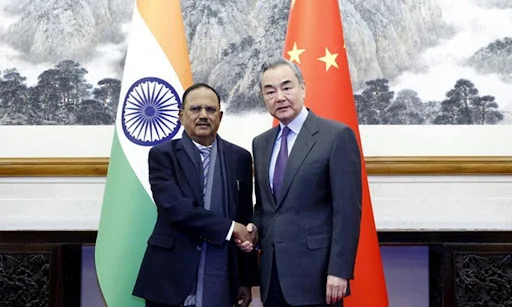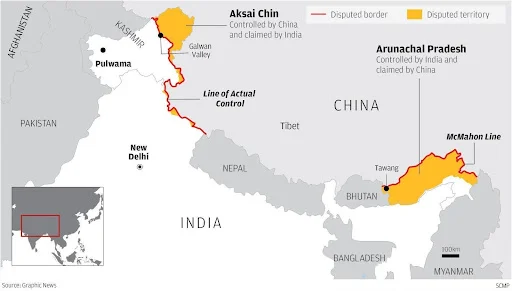Introduction
- On December 18, 2024, a significant meeting took place between India and China, marking an important milestone in efforts to normalize their strained relationship.
- The Special Representative meeting, led by India’s National Security Advisor Ajit Doval and China’s Foreign Minister Wang Yi, was the first of its kind in nearly five years.
- This formal engagement follows a period of heightened tensions and military standoffs since 2020, especially along the Line of Actual Control (LAC).
- The meeting signified a shared commitment to peaceful coexistence, even as the two nations continue to grapple with unresolved territorial disputes.

Key Outcomes of the India-China Special Representative Meeting
- Affirmation of the Disengagement Agreement: One of the major outcomes of the meeting was the reaffirmation of the disengagement agreement reached on October 21, 2024. This agreement aims to reduce tensions along the LAC in eastern Ladakh, allowing both India and China to resume patrols and grazing activities in key areas. This move is seen as a vital step toward stability in the region, helping to de-escalate the military presence on both sides.
- Six-Point Consensus Reached: During the meeting, the two sides reached a six-point consensus, which includes several cooperative measures:
- Resumption of Kailash Mansarovar Pilgrimage: India and China agreed to facilitate the resumption of the Kailash Mansarovar pilgrimage to Tibet, which had been suspended due to the tensions at the border.
- Enhanced Cooperation on Cross-Border Rivers: The agreement emphasizes the importance of collaboration on managing cross-border rivers, which has historically been both a point of cooperation and conflict.
- Promotion of Trade at Nathu La Pass: Both nations agreed to promote trade at the Nathu La Pass, a crucial trade route between India and China, aimed at enhancing economic ties.
- Strengthening Confidence-Building Measures: Emphasis was placed on building confidence and ensuring long-term peace along the border.

- Framework for Future Cooperation: Both India and China agreed to work on a framework for resolving their long-standing boundary issues. This framework would be based on the guiding principles established in 2005, following a gradual, step-by-step approach. The goal is to tackle less contentious issues first, before addressing the more complex matters, thus ensuring a manageable and peaceful resolution.
- Commitment to Peace and Tranquillity: Both sides reiterated the importance of maintaining peace and tranquillity at the borders, which is critical for the normalization of bilateral relations. To achieve this, the two countries agreed to refine the management rules for border areas and enhance diplomatic and military coordination to avoid conflicts.
- Future Meetings Planned: Looking ahead, India and China agreed to continue their dialogue through additional Special Representative meetings. The next round of talks is scheduled to take place in India in 2025. This continued engagement underscores both nations’ commitment to finding a lasting solution to their border issues.
Read also: Female Labour Force Participation Rate (FLFPR) in India | UPSC
Key Aspects of the India-China LAC Agreement
- Patrolling Protocols: The agreement allows both countries to resume patrols along established routes, aiming to return to the status quo that existed prior to the escalation of tensions in 2020. This move is crucial for reducing military encounters and ensuring stability along the LAC.
- Disengagement Process: The agreement also aims to complete the disengagement process that has been a focal point of negotiations for the past few years. This includes withdrawing forces from sensitive areas to prevent further confrontations.
- Reduction of Military Presence: As part of the agreement, both India and China have agreed to slightly reduce their military presence along the LAC to minimize the risk of conflict. The implementation will be regularly monitored, with review meetings planned to ensure that both sides comply with the new protocols.
Implications of the India-China Agreement
- De-escalation of Tensions: The agreement marks a major step towards reducing the military presence along the LAC. This is a crucial step in de-escalating tensions, significantly reducing the risk of future confrontations like the 2020 Galwan Valley clashes and creating a more stable environment for both countries.
- Restoration of Diplomatic Relations: A successful implementation of the agreement could pave the way for the resumption of higher-level diplomatic engagements in international forums such as BRICS, the Shanghai Cooperation Organisation (SCO), and others. This would allow India and China to focus on collaborative efforts in other areas, such as trade and regional security.
- Economic and Trade Relations: The de-escalation of military tensions will also improve the prospects for economic ties between India and China. For instance, the resumption of flights and the potential increase in Chinese investments in India are likely outcomes of the agreement. Additionally, the reopening of trade routes such as Nathu La Pass will provide a much-needed boost to bilateral trade.
- Influence on Regional Stability: A stable relationship between India and China has broader regional implications. It could set a precedent for resolving other territorial disputes in Asia and change how China’s border policies are perceived by neighboring countries. Furthermore, a peaceful resolution between these two major players could help ease tensions in other areas of the region.
- Path for Long-Term Territorial Resolution: The LAC agreement provides a pathway for addressing more complex territorial disputes between India and China, such as those concerning Depsang and Demchok. The ongoing dialogue and commitment to resolution are key steps in addressing these legacy issues.
McMahon Line
|
See more: Types of Unemployment Cyclic Structural Frictional Seasonal Disguised | UPSC
Challenges in Resolving the India-China Border Dispute
- Historical Disagreements: The border dispute between India and China is deeply entrenched in history, particularly dating back to the 1962 war. The presence of legacy issues, such as disputes over Depsang Plains and Demchok, complicates the resolution process, making it difficult to achieve a comprehensive solution.
- Unilateral Chinese Actions: China’s attempts to unilaterally alter the status quo along the LAC have contributed to escalating tensions in the past. For instance, Chinese incursions into Indian territory at places like Doklam (2017) and Galwan Valley (2020) have created significant friction. These actions, viewed as violations of previous agreements, such as the 1993 Agreement on the Maintenance of Peace and Tranquility along the LAC, further embolden nationalism on both sides, rendering it difficult to negotiate peace.
- Strategic and Nationalistic Concerns: The disputed areas are of immense strategic importance to both India and China. For example, the Aksai Chin region, which China controls but India claims, is critical for both defense and access to key infrastructure routes. Similarly, Arunachal Pradesh, particularly the region of Tawang, holds both strategic and symbolic significance for India, with nationalistic sentiments tied to its control. The political leadership in both countries faces internal pressure to assert sovereignty over these areas, thus hindering diplomatic flexibility.
- Military Build-up and Infrastructure Development: China’s Belt and Road Initiative and the China-Pakistan Economic Corridor (CPEC) project, which passes through disputed areas like Gilgit-Baltistan, have furthered military infrastructure development. India’s countermeasures include building strategic roads and airstrips along its border areas, such as the Dibrugarh to Tinsukia road in Arunachal Pradesh and other areas like Shyok in Ladakh. This rapid militarization makes the situation highly volatile and difficult to de-escalate.
- Lack of Trust: The Galwan Valley clashes in 2020 severely impacted trust between India and China, leading to increased suspicion. This lack of trust complicates negotiations and creates a volatile environment that hinders long-term conflict resolution.
- Imbalance in Buffer Zones: The creation of buffer zones during the disengagement process has led to India losing more territory than China. This imbalance in buffer zones has created further tensions and adds difficulty to the conflict resolution process.

Way Forward
- Continued Dialogue and Negotiations: Ongoing high-level talks should continue, keeping military, political, and diplomatic channels open. Continued engagement is essential for managing future tensions along the LAC and fostering mutual understanding between both nations.
- Building Trust: Both countries should take active steps to rebuild trust, including avoiding unilateral actions that might escalate tensions. Establishing an environment of mutual respect and understanding will be key to maintaining peace along the border.
- Addressing Legacy Issues: The long-standing territorial disputes, particularly over Depsang and Demchok, should be addressed in future negotiations. A comprehensive resolution to these legacy issues is crucial for ensuring lasting peace.
- Balanced Disengagement: Future disengagement processes must be balanced, ensuring that neither side loses disproportionately in buffer zones. Maintaining an equilibrium will be critical for a fair and lasting resolution.

